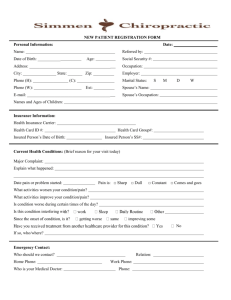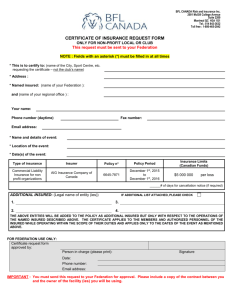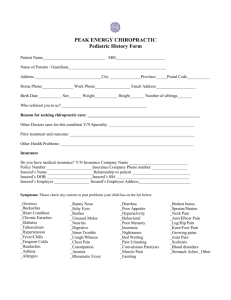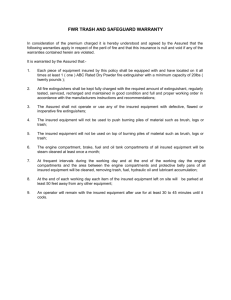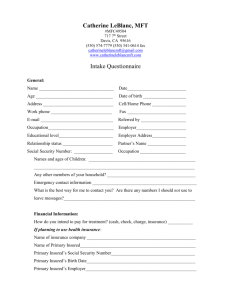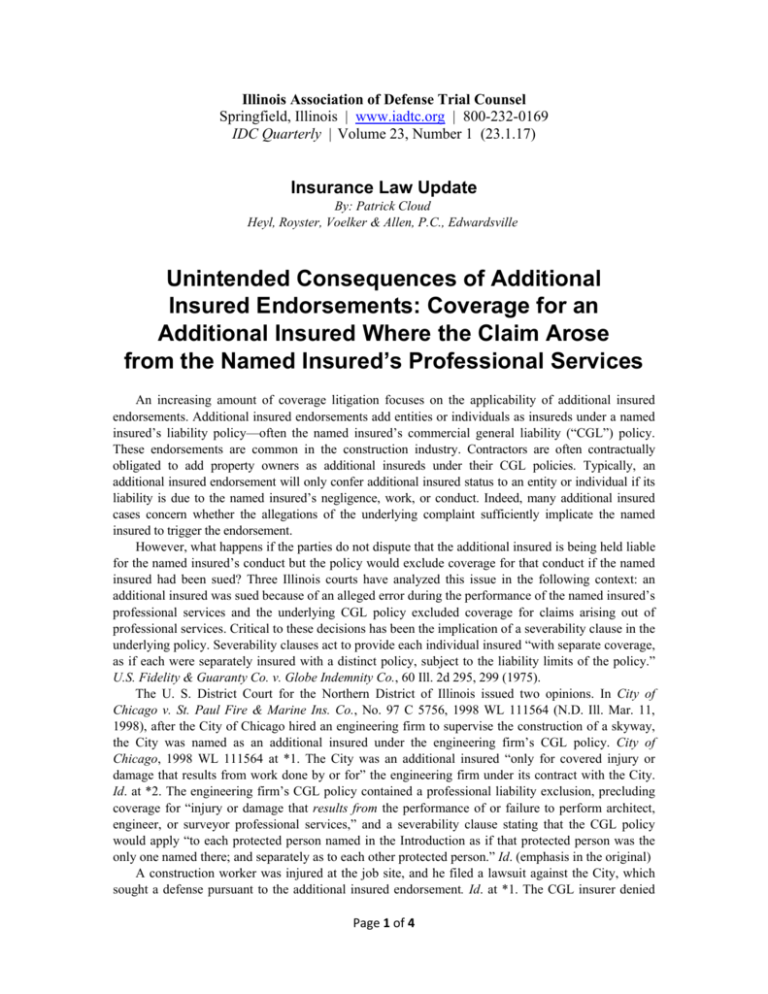
Illinois Association of Defense Trial Counsel
Springfield, Illinois | www.iadtc.org | 800-232-0169
IDC Quarterly | Volume 23, Number 1 (23.1.17)
Insurance Law Update
By: Patrick Cloud
Heyl, Royster, Voelker & Allen, P.C., Edwardsville
Unintended Consequences of Additional
Insured Endorsements: Coverage for an
Additional Insured Where the Claim Arose
from the Named Insured’s Professional Services
An increasing amount of coverage litigation focuses on the applicability of additional insured
endorsements. Additional insured endorsements add entities or individuals as insureds under a named
insured’s liability policy—often the named insured’s commercial general liability (“CGL”) policy.
These endorsements are common in the construction industry. Contractors are often contractually
obligated to add property owners as additional insureds under their CGL policies. Typically, an
additional insured endorsement will only confer additional insured status to an entity or individual if its
liability is due to the named insured’s negligence, work, or conduct. Indeed, many additional insured
cases concern whether the allegations of the underlying complaint sufficiently implicate the named
insured to trigger the endorsement.
However, what happens if the parties do not dispute that the additional insured is being held liable
for the named insured’s conduct but the policy would exclude coverage for that conduct if the named
insured had been sued? Three Illinois courts have analyzed this issue in the following context: an
additional insured was sued because of an alleged error during the performance of the named insured’s
professional services and the underlying CGL policy excluded coverage for claims arising out of
professional services. Critical to these decisions has been the implication of a severability clause in the
underlying policy. Severability clauses act to provide each individual insured “with separate coverage,
as if each were separately insured with a distinct policy, subject to the liability limits of the policy.”
U.S. Fidelity & Guaranty Co. v. Globe Indemnity Co., 60 Ill. 2d 295, 299 (1975).
The U. S. District Court for the Northern District of Illinois issued two opinions. In City of
Chicago v. St. Paul Fire & Marine Ins. Co., No. 97 C 5756, 1998 WL 111564 (N.D. Ill. Mar. 11,
1998), after the City of Chicago hired an engineering firm to supervise the construction of a skyway,
the City was named as an additional insured under the engineering firm’s CGL policy. City of
Chicago, 1998 WL 111564 at *1. The City was an additional insured “only for covered injury or
damage that results from work done by or for” the engineering firm under its contract with the City.
Id. at *2. The engineering firm’s CGL policy contained a professional liability exclusion, precluding
coverage for “injury or damage that results from the performance of or failure to perform architect,
engineer, or surveyor professional services,” and a severability clause stating that the CGL policy
would apply “to each protected person named in the Introduction as if that protected person was the
only one named there; and separately as to each other protected person.” Id. (emphasis in the original)
A construction worker was injured at the job site, and he filed a lawsuit against the City, which
sought a defense pursuant to the additional insured endorsement. Id. at *1. The CGL insurer denied
Page 1 of 4
that it had a duty to defend the City “because (1) [the engineering firm] was only hired to provide
professional services on the Chicago Skyway Project and (2) the [CGL] policy does not cover injury
or damage that results from the performance or the failure to perform supervisory or engineering
professional services.” Id. at *2 (emphasis in original). The City argued that the professional services
exclusion was inapplicable because “the City’s potential liability arises from its own alleged
negligence or from its status as the property owner” and because “the City itself did not engage in
professional services on the Chicago Skyway Project.” Id. at *3 (emphasis in original). Upon cross
motions for summary judgment, the Northern District found that the City of Chicago cast sufficient
doubt on the applicability of the policy’s professional services exclusion to render the exclusion
inapplicable as a matter of law, reasoning:
The [CGL] policy does not clearly rule out the possibility of the City receiving coverage
where [the engineering firm] is denied coverage. An insurer has an obligation to an
additional insured distinct from its obligation to the named insured. . . .
True, the policy requires the covered injury or damage to result from the work done by or for
[the engineering firm], and [the engineering firm] may have only done professional work.
But the policy does not speak clearly to the situation presented here: injuries that allegedly
“result from” both (1) work done by [the engineering firm] and (2) the additional insured’s
negligence.
City of Chicago, 1998 WL 111564 at *4. Eventually, the CGL carrier succeeded in the declaratory
judgment action and did not have to defend the City—albeit not on this issue but one related to
whether the carrier was given appropriate notice of the City’s additional insured status. See City of
Chicago v. St. Paul Fire, No. 97 C 5756, 1998 WL 171787 (N.D. Ill. April 10, 1998).
Twelve years after City of Chicago, the Northern District addressed this issue again in U.S.
Fidelity & Guaranty Co. v. Shorenstein Realty Services, L.P., 700 F. Supp. 2d 1003 (N.D. Ill. 2010).
In Shorenstein, after an engineering firm was hired to restore the Hancock building, a realty company
(one of the building’s owners) was named as an additional insured under the engineering firm’s CGL.
Shorenstein Realty Services, L.P., 700 F. Supp. 2d at 1006-07. The additional insured endorsement did
not apply unless the bodily injury was “caused in whole or in part by the negligent acts or omissions
of any Named Insured.” Id. at 1007. The policy also contained a provision stating that the insurance
did not apply to an additional insured for bodily injury “arising out of an architect’s, engineer’s or
surveyor’s rendering or failure to render any professional services for you, for the ADDITIONAL
INSURED, or for others.” Id. (emphasis in original). The policy contained a severability clause,
stating the insurance applied “[a]s if each Named Insured were the only Named Insured” and
“[s]eparately to each insured against whom claim is made or ‘suit’ is brought.” Shorenstein Realty
Services, L.P., 700 F. Supp. 2d at 1011.
Scaffolding fell from the Hancock building and injured and killed individuals on the ground. Id. at
1004. Subsequently, individuals filed suit against the realty company. Id. The realty company and its
insurer sought indemnification under the additional insured endorsement from the engineering firm’s
CGL carrier. Id. at 1004-05. The CGL carrier denied the claim, maintaining that the additional insured
endorsement did not provide coverage because the accident arose from the engineering firm’s
professional services. Id. at 1008.
The parties filed cross-motions for summary judgment. The District Court found that coverage
existed under the additional insured endorsement. Id. at 1016, 1022. According to the District Court,
“[o]n a straightforward reading,” the severability clause of the policy indicated that the policy should
be applied to the realty company independently of the engineering firm. Id. at 1011. Therefore, the
relevant question was whether the claim arose from the realty company’s professional services—not
whether the engineering firm was engaging in professional services. Id. at 1010-11. Furthermore, the
Page 2 of 4
District Court feared that an adoption of the CGL carrier’s position would lead to illusory insurance
coverage. Id. at 1011. As the District Court noted, the engineering firm “was hired to essentially
perform only professional services,” and, if the realty company was “not covered for injuries arising
out of [the engineering firm’s] professional services, the Policy appears to provide [it] without any
protection for [the engineering firm’s] conduct at all.” Id.
The Illinois Appellate Court also encountered this issue in Patrick Engineering, Inc. v. Old Republic
General Insurance Co., 2012 IL App (2d) 111111. Here, Commonwealth Edison Company
(“ComEd”) entered into an agreement with an engineering firm to design the relocation of utility
poles. The agreement required the engineering firm to add ComEd as an additional insured to its
CGL. Patrick Engineering, Inc., 2012 IL App (2d) 111111 ¶ 4. ComEd was only an additional
insured for liability arising out of the engineering firm’s work. Id. ¶ 18. The CGL policy had a
professional liability exclusion stating that the insurance did not apply to property damage “arising out of
the rendering of or failure to render any professional services by you or any engineer, architect or
surveyor who is either employed by you or performing work on your behalf in such capacity.” Id. ¶ 17.
The policy defined “you” as the Named Insured – ComEd was not included within the definition of
“you.” Id. ¶ 19. The CGL policy contained a severability clause, stating that the policy applied
“separately to each insured . . . against whom claim claim [sic.] is made or ‘suit’ is brought.” Id. ¶ 17.
After a village sued ComEd because ComEd smashed through an underground sewer facility
during the project, ComEd submitted the suit for a defense under the engineering firm’s CGL. Id. ¶ 6.
The carrier denied the claim, asserting that the professional liability exclusion applied to any claim
arising out of the named insured’s professional services. Id. ¶ 29. Thus, because the suit arose out of
the engineering firm’s design of the relocation project, the claim was not covered. Id. ¶ 12. In the
coverage litigation, the parties agreed on the following propositions:
•
•
•
“[T]he CGL policy covered general liability for damage arising out of nonprofessional or laborbased services, and not for damages arising out of professional services; according to all parties,
that is the purpose of the CGL policy;”
The engineering firm, “the named insured, provided only professional services, in the form of
engineering design (and, therefore, clearly was barred from coverage),” and
“ComEd, the additional insured, provided no professional services.”
Id. ¶ 12. The circuit court granted the CGL carrier’s motion for summary judgment. Id. ¶ 13.
On appeal, the Illinois Appellate Court reversed. Adopting an analysis similar to Shorenstein and
City of Chicago, the appellate court found that, in light of the severability clause, if the additional
insured did not provide professional services, the insurer had a duty to defend, even if a professional
services exclusion would preclude coverage for the named insured. Patrick Engineering, Inc., 2012 IL
App. (2d) 111111 ¶¶ 24-28. On appeal, the CGL carrier attempted to distinguish Shorenstein and City
of Chicago. It argued that the professional services exclusion within the policy referred directly to the
named insured and precluded coverage for any claim arising out of the named insured’s professional
services—which would have included the claims against ComEd. Id. ¶ 29. The appellate court rejected
this distinction, responding:
In any case, that the professional-services exclusion in the instant policy expressly refers to
[the engineering firm], the named insured, as opposed to any insured or any professional, is
an irrelevant distinction that, if anything, works against [the insurer]. The general terms used
in the cited cases, i.e. “an engineer,” “by or on behalf of any insured,” and “engineer
professional services,” implicate both a named insured and any insured that performed the
listed professional services. Limiting the exclusion to professional services “by or for” the
named insured, as opposed to any insured or any engineer, would only narrow the
Page 3 of 4
applicability of the exclusion and thereby broaden the umbrella of those covered under the
policy.
Id. ¶ 30 (emphasis in original).
City of Chicago, Shorenstein, and Patrick Engineering present interesting situations because the
CGL carriers in each case found themselves in unexpected positions. Each carrier issued policies that
sought to exclude coverage for claims arising from the named insured’s professional services.
However, due to the operation of additional insured endorsements and severability clauses, these
insurers found themselves exposed to risks and claims that they did not anticipate. This may be of
particular concern in Patrick Engineering, where the professional services exclusion appeared to
preclude any claim arising out of the named insured’s professional services—irrespective of whether
the named insured or another insured was the target of the claim. Thus, these cases have significance
for insurers who issue CGL policies to a professional service provider who is likely to add parties as
additional insureds (such as architects or engineering firms). If the insurer wants to exclude coverage
for any claim arising out of the provider’s professional services (even if against the additional
insured), it is imperative that the insurer make this clear in the policy—whether in the additional
insured endorsement itself or otherwise in the policy.
About the Author
Patrick Cloud is an attorney in Heyl Royster’s Edwardsville office. Patrick concentrates his practice on insurance coverage litigation,
toxic tort matters, complex civil litigation, and products liability defense. As part of his practice, Patrick takes a lead role in significant
pretrial discovery, motions and briefs, such as those involving federal preemption, forum non conveniens, the Illinois Frye doctrine,
consumer fraud, and insurance coverage litigation pending throughout the Midwest, including Illinois and Missouri.
About the IDC
The Illinois Association Defense Trial Counsel (IDC) is the premier association of attorneys in Illinois who devote a substantial
portion their practice to the representation of business, corporate, insurance, professional and other individual defendants in civil
litigation. For more information on the IDC, visit us on the web at www.iadtc.org.
Statements or expression of opinions in this publication are those of the authors and not necessarily those of the association.
IDC Quarterly, Volume 23, Number 1. © 2013. Illinois Association of Defense Trial Counsel. All Rights Reserved. Reproduction in
whole or in part without permission is prohibited.
Illinois Association of Defense Trial Counsel, PO Box 588, Rochester, IL 62563-0588, 217-498-2649, 800-232-0169, idc@iadtc.org
Page 4 of 4


